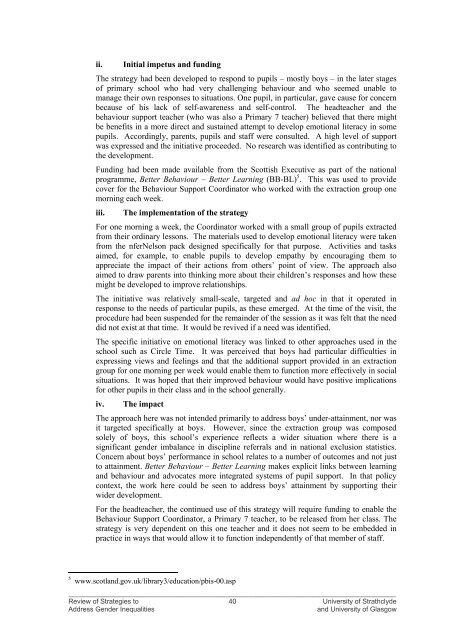Review of Strategies to Address Gender Inequalities in Scottish ...
Review of Strategies to Address Gender Inequalities in Scottish ...
Review of Strategies to Address Gender Inequalities in Scottish ...
Create successful ePaper yourself
Turn your PDF publications into a flip-book with our unique Google optimized e-Paper software.
ii. Initial impetus and fund<strong>in</strong>gThe strategy had been developed <strong>to</strong> respond <strong>to</strong> pupils – mostly boys – <strong>in</strong> the later stages<strong>of</strong> primary school who had very challeng<strong>in</strong>g behaviour and who seemed unable <strong>to</strong>manage their own responses <strong>to</strong> situations. One pupil, <strong>in</strong> particular, gave cause for concernbecause <strong>of</strong> his lack <strong>of</strong> self-awareness and self-control. The headteacher and thebehaviour support teacher (who was also a Primary 7 teacher) believed that there mightbe benefits <strong>in</strong> a more direct and susta<strong>in</strong>ed attempt <strong>to</strong> develop emotional literacy <strong>in</strong> somepupils. Accord<strong>in</strong>gly, parents, pupils and staff were consulted. A high level <strong>of</strong> supportwas expressed and the <strong>in</strong>itiative proceeded. No research was identified as contribut<strong>in</strong>g <strong>to</strong>the development.Fund<strong>in</strong>g had been made available from the <strong>Scottish</strong> Executive as part <strong>of</strong> the nationalprogramme, Better Behaviour – Better Learn<strong>in</strong>g (BB-BL) 5 . This was used <strong>to</strong> providecover for the Behaviour Support Coord<strong>in</strong>a<strong>to</strong>r who worked with the extraction group onemorn<strong>in</strong>g each week.iii. The implementation <strong>of</strong> the strategyFor one morn<strong>in</strong>g a week, the Coord<strong>in</strong>a<strong>to</strong>r worked with a small group <strong>of</strong> pupils extractedfrom their ord<strong>in</strong>ary lessons. The materials used <strong>to</strong> develop emotional literacy were takenfrom the nferNelson pack designed specifically for that purpose. Activities and tasksaimed, for example, <strong>to</strong> enable pupils <strong>to</strong> develop empathy by encourag<strong>in</strong>g them <strong>to</strong>appreciate the impact <strong>of</strong> their actions from others’ po<strong>in</strong>t <strong>of</strong> view. The approach alsoaimed <strong>to</strong> draw parents <strong>in</strong><strong>to</strong> th<strong>in</strong>k<strong>in</strong>g more about their children’s responses and how thesemight be developed <strong>to</strong> improve relationships.The <strong>in</strong>itiative was relatively small-scale, targeted and ad hoc <strong>in</strong> that it operated <strong>in</strong>response <strong>to</strong> the needs <strong>of</strong> particular pupils, as these emerged. At the time <strong>of</strong> the visit, theprocedure had been suspended for the rema<strong>in</strong>der <strong>of</strong> the session as it was felt that the needdid not exist at that time. It would be revived if a need was identified.The specific <strong>in</strong>itiative on emotional literacy was l<strong>in</strong>ked <strong>to</strong> other approaches used <strong>in</strong> theschool such as Circle Time. It was perceived that boys had particular difficulties <strong>in</strong>express<strong>in</strong>g views and feel<strong>in</strong>gs and that the additional support provided <strong>in</strong> an extractiongroup for one morn<strong>in</strong>g per week would enable them <strong>to</strong> function more effectively <strong>in</strong> socialsituations. It was hoped that their improved behaviour would have positive implicationsfor other pupils <strong>in</strong> their class and <strong>in</strong> the school generally.iv. The impactThe approach here was not <strong>in</strong>tended primarily <strong>to</strong> address boys’ under-atta<strong>in</strong>ment, nor wasit targeted specifically at boys. However, s<strong>in</strong>ce the extraction group was composedsolely <strong>of</strong> boys, this school’s experience reflects a wider situation where there is asignificant gender imbalance <strong>in</strong> discipl<strong>in</strong>e referrals and <strong>in</strong> national exclusion statistics.Concern about boys’ performance <strong>in</strong> school relates <strong>to</strong> a number <strong>of</strong> outcomes and not just<strong>to</strong> atta<strong>in</strong>ment. Better Behaviour – Better Learn<strong>in</strong>g makes explicit l<strong>in</strong>ks between learn<strong>in</strong>gand behaviour and advocates more <strong>in</strong>tegrated systems <strong>of</strong> pupil support. In that policycontext, the work here could be seen <strong>to</strong> address boys’ atta<strong>in</strong>ment by support<strong>in</strong>g theirwider development.For the headteacher, the cont<strong>in</strong>ued use <strong>of</strong> this strategy will require fund<strong>in</strong>g <strong>to</strong> enable theBehaviour Support Coord<strong>in</strong>a<strong>to</strong>r, a Primary 7 teacher, <strong>to</strong> be released from her class. Thestrategy is very dependent on this one teacher and it does not seem <strong>to</strong> be embedded <strong>in</strong>practice <strong>in</strong> ways that would allow it <strong>to</strong> function <strong>in</strong>dependently <strong>of</strong> that member <strong>of</strong> staff.5 www.scotland.gov.uk/library3/education/pbis-00.asp______________________________________________________________________________________<strong>Review</strong> <strong>of</strong> <strong>Strategies</strong> <strong>to</strong> 40 University <strong>of</strong> Strathclyde<strong>Address</strong> <strong>Gender</strong> <strong>Inequalities</strong>and University <strong>of</strong> Glasgow
















